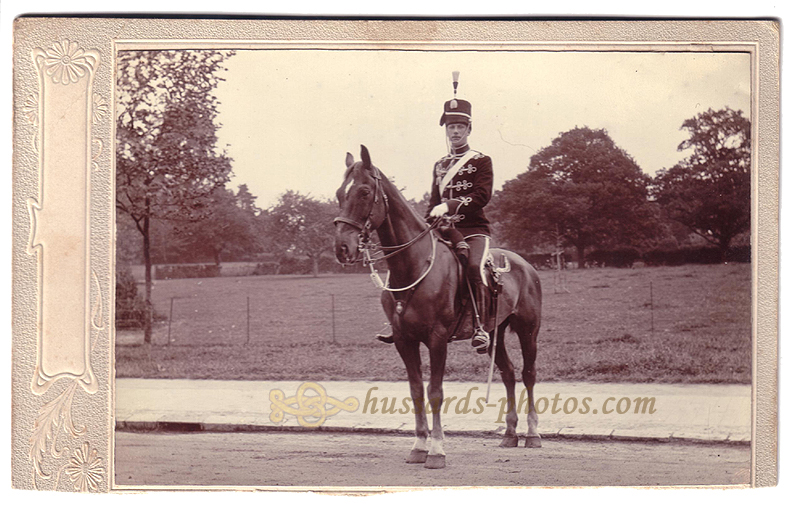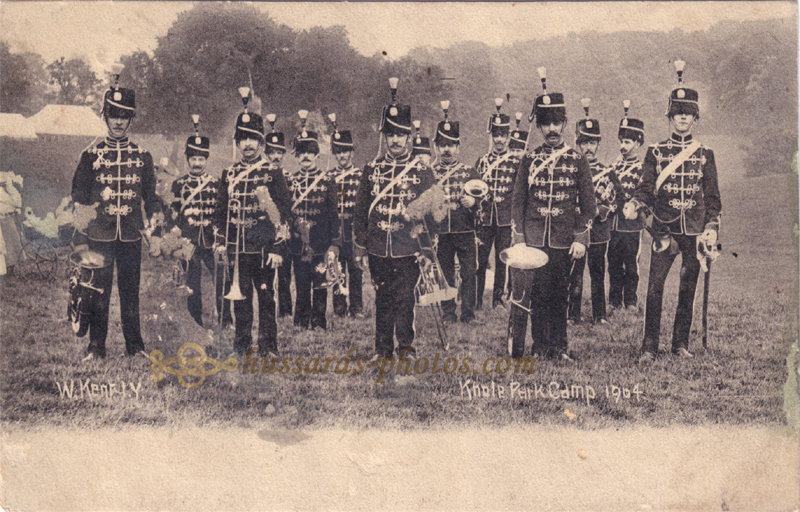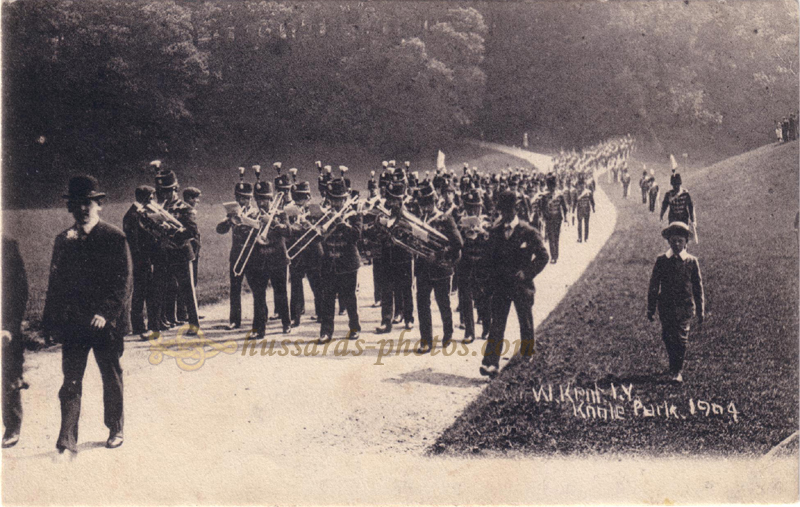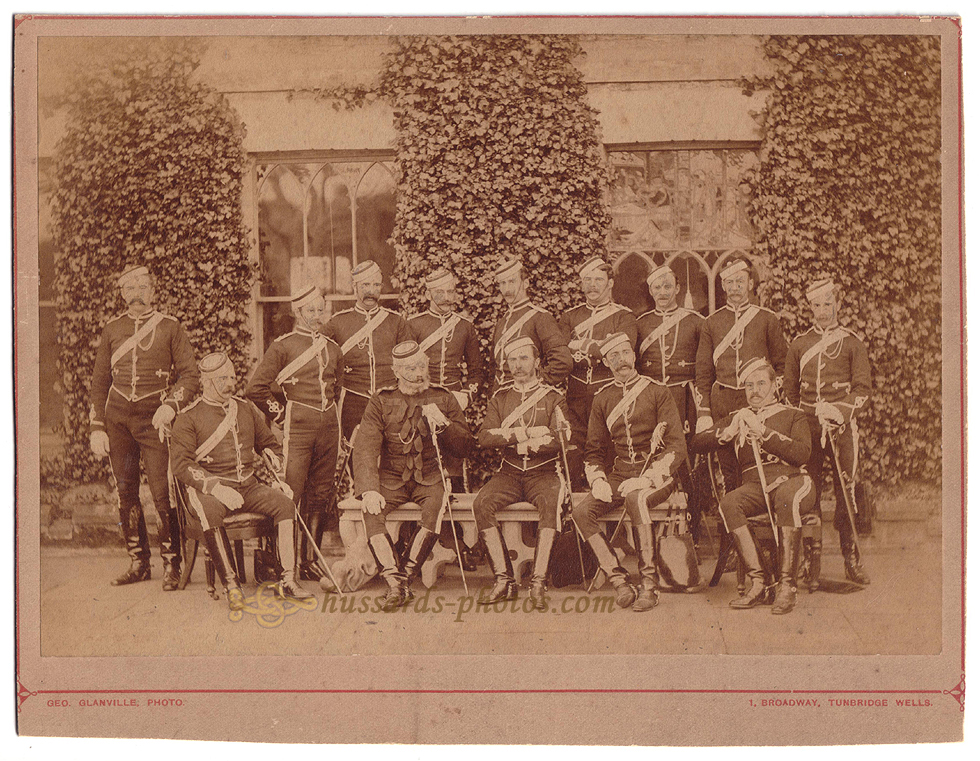| To the left is the list
of the West Kent Yeomanry Officers, as per the December 1880 Army
Lists.
The following changes occured to that
establishment in 1881-82 :
- On February 16 1881, Lieut. the Hon. Frederick Amherst
resigned his commission ;
- On July 20 1882, Philip Green resigned his commission,
being permitted to retain his rank, and to continue to wear the
uniform of the Regiment on his Retirement ;
That list is thus not very far from
naming all the officers on the photograph. They are in undress
order ; their stable jackets are dark blue with silver lace and
scarlet facings (cuffs and collar).
The Field Officer sitting in the center
of that photograph is Lieutenant-Colonel Fitzroy Maclean.
It is likely that the Field Officer
sitting on his right is Major Wm. Henry Roberts.
The older gentleman in patrol jacket to
his left may well be William Nevill, 5th Earl and 1st Marquess of
Abergavenny, Honorary Colonel of the Regiment (Eridge Castle was
his residence).
Lieutenant-Colonel Fitzroy D. Maclean is
a fascinating character ; here is his obituary, reproduced from
The Times, November 26, 1936 (!) :
|
|
Sir Fitzroy Maclean
Crimean Veteran and Chief of his Clan
Sir Fitzroy Donald Maclean, Bt.,
who died yesterday at Duart Castle, Isle of Mull, at the age of 101,
Chief of his Clan and a Crimean veteran, was one of the best known
of the "grand old men" of Scotland.
When a boy in his early teens he was taken by his father to see the
ruins of Duart Castle, burnt to the ground two centuries before, and
then made a vow to restore it to its former glory. The vow was
redeemed in 1912, when the yellow banner of the Chief of the Clan
once more floated over the castle walls amid the rejoicings of the
chieftains and clansmen from all parts of the world.
His lineage goes back to Gillean of the Battle-Axe, founder of the
Clan Gillean, whose grandson fought at Bannockburn and was the
father of John Dubh, who held Dowart orDuart and other lands in the
Isle of Mull. All through Scottish history his forebears were good
fighters.
He was born on May 1835, the only son of Colonel Sir Charles Fitzroy
Maclean, the ninth baronet. After having spent a few weeks as a cornet
in the 7th Dragoon Guards he was transferred on October 12, 1852, to
the 13th Light Dragoons. In this regiment, which afterwards became
the 13th Hussars, he served until September, 1873, being its colonel
from February, 1871. Having been promoted lieutenant in October,
1854, and captain in 1856, he served in Bulgaria and in the Crimean
War. He was at the Cavalry affair of Buljanak, but missed being in
the Charge of the Light Brigade owing to illness. He was, however,
present throughout the battle of the Alma and at the siege of
Sebastopol, and received the medal and two clasps, and the Turkish
war medal. From May, 1858, to September, 1859, he was A.D.C. to
Field-Marshal Lord Seaton, and from 1860 to 1861 to General Sir
George Brown.
He became a major in August, 1861, and in 1865 was selected to
report on the french Cavalry manoeuvres. From September, 1866, to
July, 1869, he served in Canada, whither the regiment had been sent
to cope with the trouble which was apprehended as the result of the
Fenian conspiracy. From 1880 to 1899 he commanded the West Kent
Queen's Own Yeomanry Cavalry. He succeeded his father as tenth
baronet in 1883. He was made a C.B. in 1897 and promoted K.C.B. in
1904.
Sir Fitzroy, who was twenty-sixth Chief of the Clan Maclean, entered
into possession, in August, 1912, of Duart Castle, in the Isle of
Mull, which, after a lapse of 200 years, had again become the family
home. Members of the Clan from all parts of the United Kingdom, the
Dominions, and America, crossed from Oban to the Isle of Mull on the
occasion of their Chief's formal entry to the stronghold of his race.
More than 400 clansmen headed by pipers marched from the landing
place. Maclean of Ardgour, the senior Chieftain under the Chief,
beat upon the door of the castle and in Gaelic summoned the Man of
Duart to come and receive the greetings of his clan in the home of
his ancestors. The Chief responded by welcoming his guests in Gaelic.
Having unfurled the banner of ownership, he read a letter from Mrs.
Guthrie, of Duart House, the former proprietor of the castle,
intimating that she was changing the name of her estate so that
Duart might stand alone as a Maclean possession. The Duke of Argyll,
whose ancestors had taken the castle from the Macleans, sent a
telegram of congratulation.
On the Chief's hundredth birthday, there was another great assembly
of the clansfolk. Last year, when he became 101, there was only a
family gathering, but the Chief, though confined to his room,
continued to take the keenest interest in the Clan.
Sir Fitzroy, who was much beloved, was Grand President of the Clan
Gillean or Maclean Association, honorary president of the Mull and
Iona Association, vice-president and formerly president of the
Highland Society of London. He was appointed a deputy lieutenant for
Argyllshire in 1932. He married in 1872 Constance Marianne, daughter
of Mr. G.H.Ackers, of Moreton Hall, Cheshire. She died in 1920,
leaving two sons and one daughter, the wife of Brigadier F.W.Bullock-Marsham.
Sir Fitzroy's elder son, Major Hector Fitzroy Maclean, Scots Guards,
who married Winifred Joan, daughter of Mr.J.H.Wilding, died in 1932,
and he is succeeded by his grandson, Charles Hector Fitzroy, born in
1916.
|




